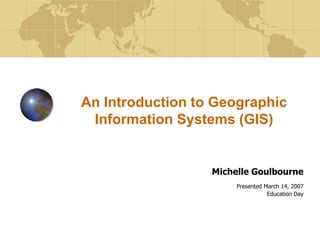
Introduction to GIS
- 1. An Introduction to Geographic Information Systems (GIS) Michelle Goulbourne Presented March 14, 2007 Education Day
- 2. Objectives Explain what a geographic information system (GIS) is. Provide a history of GIS. Describe different types of data elements. Explain spatial scales. Provide an overview of the map elements. Introduce 4 different types of maps.
- 3. Definition “GIS is a collection of computer hardware, software, and geographic data for capturing, managing, analyzing, and displaying all forms of geographically referenced information.” http://www.gis.com/whatisgis/index.cfm
- 4. What is a GIS Acronym for Geographic Information Systems. In a GIS, we combine geographic locations with descriptive data about the locations. Database and map are linked to allow us to perform Queries Statistical analyses Geographical analyses Visualize the results on a map The goal is to help us gain a better understanding of our world so we can enhance planning and decision making.
- 5. History of GIS 1854 Dr. John Snow created a map to show the locations of death by cholera in central London. This technique was used to track the source to a contaminated well. 1960s Roger Tomlinson helped to design and develop the Canadian GIS (CGIS). The CGIS was used to manage and analyze Canada Land Inventory Data monitor and the environment. 1960s SYMAP the 1st mapping package developed by Howard Fisher. Increased access to data and technological advances such as having smaller more powerful computers with greater storage capacity has helped the field to develop rapidly.
- 6. Components of a GIS Geographical locations (spatial data) Information about the locations (attributes or non-spatial data) Software for storing and managing the data. Computers to facilitate the data storage, processing and analysis. People to operate the GIS
- 7. Data Types Attribute Data Location Data What is it? Where is it? • road • XY Coordinate data How can we describe it? (latitude and longitude) • Name • Class • Length of road segment • Date of construction
- 8. Map Layers Spatial data contain the coordinates and identifying information that is necessary to draw maps. A layer is a collection of all the features in the map that share some common characteristic. Three types of layers can be represented in a GIS: points, lines, and areas When the various layers are overlaid, they form a map
- 9. 5 Functions of a GIS Data acquisition Preprocessing Data management Manipulation and analysis Generation of maps, images, reports and tables.
- 10. 7 Types of Questions a GIS Can Answer Can you map that? Where is that? What has changed? What relationships exist? Where is it best? What afffects what? What if? Source: Joseph K. Berry (1995) Spatial Reasoning for Effective Reasoning. GIS World Books.
- 11. Demand and Supply M. Goulbourne
- 12. Purchase Power M. Goulbourne
- 13. Map of Suitable Areas M. Goulbourne
- 14. Representing Map Features Representation of real-world objects on a map using symbols and their locations and geometry with: Point objects Line objects Area or polygon objects Volume objects Grid cells Vector Data Structure Points, lines and polygons Raster Data Structure Grid cells
- 15. Vector / Raster
- 16. Scale Ratio of the size of the entity represented on a map to the size of the entity in reality. 10km road can be represented by 1cm line on a map. • 1cm on the map is equal to 1,000,000cm in reality. • Scale = 1:1,000,000 • Smaller scale -> less detailed 100km road can be represented by 1cm line on a map. • 1cm on the map is equal to 10,000cm in reality. • Scale = 1:10,000 • Larger Scale - > more detailed
- 17. Scale Example Larger Scale Smaller Scale http://education.usgs.gov/common/lessons/teaching_about_scale.pdf
- 18. Anatomy of a Map
- 19. 1. Chlorpleth Maps Shows predefined set of areas classified by a particular attribute of the area. Water Use http://en.wikipedia.org/wiki/Image:Choropleth.gif
- 20. 2. Contour / Isoline Map Shows lines connecting points of equal value.
- 21. 3. Dot Map Plots point locations to show the spatial distribution of the points. http://en.wikipedia.org/wiki/Image:Johnsnow.gif
- 22. 4. Symbol Maps Use symbols of various sizes and shapes to represent variations of an attribute. “The National Public Toilet Map is part of the Australian government's National Continence Management Strategy (NCMS). The map allows more Australians with urinary and fecal incontinence problems to live and participate in their communities with dignity and confidence, by making it easier for them to find information about the location of public toilets.“ http://en.wikipedia.org/wiki/National_Public_Toilet_Map
- 23. Thank you
